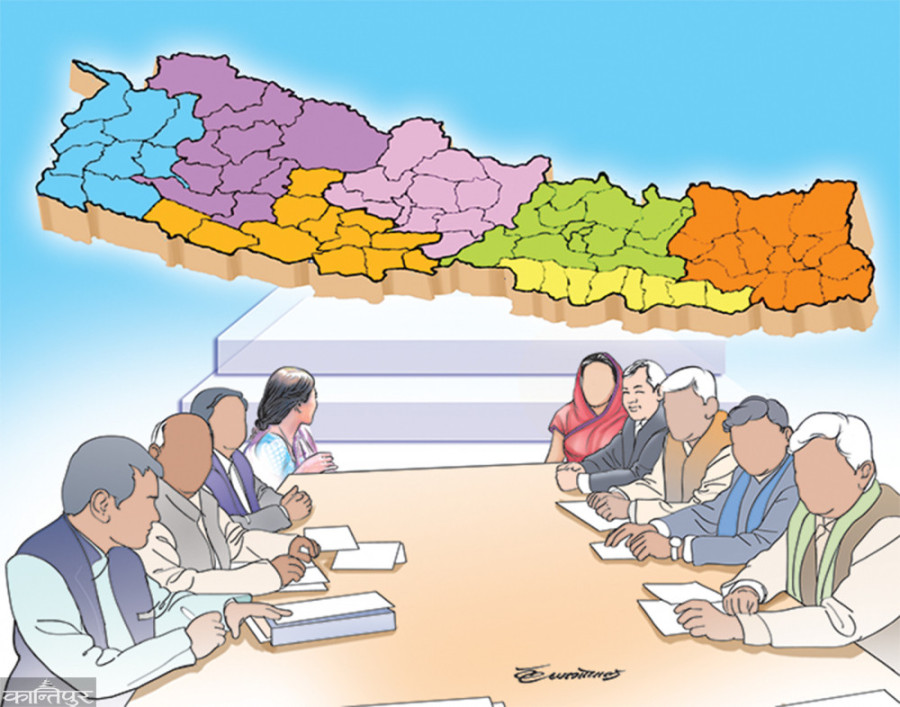Columns
Provinces versus Kathmandu
Attitude towards federalism in Nepal is still marked with scepticism.
Semanta Dahal
Be it for the municipal executive, the provincial legislature or the federal parliament, candidates hitting the campaign trail along the mid-hills of Nepal had to woo the voters during the last elections on an unconventional agenda: Curbing the monkey menace. Strong commitments were made, but after the elections, no government has done anything tangible to address this problem. What can exacerbate this problem even more and allow the elected office bearers to shy away from responsibility is the ambiguity that has come attached to federalism, especially about the purview of the federal, provincial and local governments over a range of subjects, including monkeys! As a matter of fact, there is also an old Canadian joke on federalism resembling this issue: The elephant—is it a federal or provincial responsibility?
The five lists
Three Cs used by the constitution to describe the characteristics of Nepal’s federative nature are cooperation, co-existence and coordination. These terms, however, get reduced to mere ornate terminologies if the list of subjects enumerated per Article 57 of the constitution in the five annexed appendices dividing the power and functions between three orders of the government is overlooked. The five lists dividing the powers amongst the federal, provincial and local levels, therefore, lie at the heart of Nepal’s federal design.
The list of 35 federal subjects is set out in Schedule 5, which encompasses national defense, international affairs, central taxes, banking, central universities, citizenship, mineral exploration, central infrastructure projects, and criminal and civil laws. The provinces are given control over 21 subjects in Schedule 6, including provincial police administration, radio/FM/televisions, provincial taxes (land registration, tourism, entertainment, advertisement, agricultural income, vehicle, etc.), cooperatives, land management, provincial-level projects, and universities. Twenty-two subjects primarily associated with cooperatives, local level taxes (property taxes, rental taxes, entertainment, advertisement), agriculture, local roads, drinking water and disaster management fall under the authority of local government in Schedule 8. Schedules 7 and 9 are concurrent lists containing shared subjects between federal and provincial, and federal, provincial and local levels, respectively. In these concurrent matters, the governments are required to work in collaboration with each other, and in case of any inconsistency, the federal framework takes precedence. Any residual issues rest with the federal level.
Province-Federal disputes
Even though the constitution demarcates power and functions into three multifold levels, disputes invariably arise in exercising political power under these schedules. In case of such disputes, Part 10 of the constitution assigns disputes of a political nature to the Inter-Provincial Council headed by the Prime Minister, with an explicit caveat that the Supreme Court enjoys jurisdiction under Article 137(2)(a) over federal vs province, province vs province, province vs local and local vs local disputes. Article 137(2)(a) empowers the Supreme Court to determine the jurisdictional boundaries of the three strata of the government.
A recent trend suggests that Article 137(2)(a) of the constitution is increasingly resorted to call upon the Supreme Court to examine the inter-jurisdictional disputes between the three orders of the government. A cursory survey of the Supreme Court docket reveals approximately 11 such cases. The majority of these cases have been moved by the Madhesh Province against the Federal Government, challenging matters ranging from the mobilisation of civil servants, recruitment of police officials, and investigation of criminal offences to protests against bids called by the federal ministry for groundwater projects.
In a few instances, individual petitions have been filed under Article 137(2)(a), questioning the decisions to declare provincial capitals and change administrative centres of municipalities. Most recently, Bagmati Province brought an action against Kathmandu seeking a determination that transport management is a provincial subject. Besides, Article 137(2)(a) of the constitution, meant to declare laws inconsistent with the constitution void, is also often invoked. Under this provision, around 19 cases are challenging the vires of provincial laws vis-à-vis the constitution and federal laws and roughly 46 other cases are contesting that the laws passed by local governments breach the constitution and federal legislation.
Umpire of the federation
While intergovernmental controversies increasingly occupy a fair share of constitutional litigations pending before the Supreme Court, it is unfortunate that the top court has not adjudicated even a single case filed under Article 137(2)(a) of the constitution. Apart from interpreting the most important question of the division of law-making powers, a couple of other preliminary issues merit deeper examination and will benefit from the Supreme Court’s immediate clarifications. The first issue relates to the locus standi of parties other than the affected tier of government to invoke Article 137(2)(a), and the second one relates to whether the constitutionality of divisions of powers is a jurisdictional dispute under Article 137(2)(a) or a question of constitutional conflict under Article 133(1) of the constitution.
Attitude towards federalism in Nepal is still marked with scepticism, albeit the understanding of the public on how the federal form of government functions is increasing. The Supreme Court can play a pivotal role in quelling the concerns and overcoming the apprehensions of federalism failing by establishing a rich jurisprudence which defines the boundaries of law-making powers between federal, provincial and local levels. Novel legal principles can be developed, or doctrines of federalism such as pith and substance, inter-jurisdictional immunity, ancillary powers, principles of subsidiarity, and federal paramountcy can be applied with modifications to Nepal’s federal context. Otherwise, even the Supreme Court will have to take the blame for handing federalism into the paws of monkeys!




 5.4°C Kathmandu
5.4°C Kathmandu













%20(1).jpg&w=300&height=200)

